Adrian Collins's Blog, page 36
November 16, 2024
REVIEW: The Penguin
The Penguin is a series that I did not initially pay much attention to, despite my mammoth Batman fandom. I felt that The Batman was an okay movie and Robert Pattinson did a good job as “Bruce Wayne who listened to the Cure growing up.” Still, I felt that the Penguin was an odd choice to make the star of his own series. Previous “Batman series without Batman” like Pennyworth and Gotham suffered for the absence of the Caped Crusader.
 There’s also the fact that this is a review for Grimdark Magazine, so the question is whether the subject is grimdark. After all, it is a comic book from a well-known family friendly property. Batman is many things but one of them is a hero and grimdark thrives with moral ambiguity, if not outright villain protagonists.
There’s also the fact that this is a review for Grimdark Magazine, so the question is whether the subject is grimdark. After all, it is a comic book from a well-known family friendly property. Batman is many things but one of them is a hero and grimdark thrives with moral ambiguity, if not outright villain protagonists.
So, it’s weird that The Penguin is probably the best Batman property since the Animated Series if not ever. No, seriously, this show is fantastic from beginning to end. Colin Farrell puts on a ludicrous amount of costuming and a fake Italian accent yet somehow delivers one of the best performances I can remember. Co-stars Cristin Milioti (Sofia Falcone) and Rhenzy Feliz (Victor Aguilar) also turn in amazing performances. Indeed, of The Penguin’s many talented actors, Mark Strong is probably the only weak performance, and even he does a serviceable job as Carmine Falcone.
The Penguin’s premise is that Oswald “Oz” Cobb (not Cobblepot) is a mid-level Italian mobster in this universe as opposed to being the criminal mastermind he usually is. He’s a working-class crook this time around instead of a fallen billionaire’s heir and even envisions himself as a man of the people. It’s a change from the comic books but the Penguin has had multiple origins so it’s not as big a change as one might think. Besides, the fact that the Penguin is centrally tied to ideas about wealth and class in America comes through well in these eight episodes.
The short version of what happens is that Oz lets his temper get the better of him during a discussion about who is going to inherit the late Carmine Falcone’s throne. This one impulsive action sets off a domino effect of events where Oz is constantly forced to scheme as well as plot to dig himself out of the hole that he’s dug for himself. This includes recruiting a disabled young man to be his No. 1# henchman and dealing with the return of Carmine Falcone’s daughter, Sofia, who has spent the past ten years in Arkham Asylum.
For the most part, The Penguin benefits from the fact that it could be any other mob movie rather than a superhero movie. The show never acts ashamed of its superhero roots, though, and gradually the story ramps up until it starts becoming more obviously something taking place in Gotham City. Certainly, it’s not that much different than the Gotham of The Batman (2022) onscreen and has several important references to the movie. While Batman’s lack of presence throughout the show is a bit disappointing, I felt the show more than made up for it with the final shot of the show. No, I won’t spoil it but it recontextualizes a lot of the show’s place in the larger iteration of the franchise here.
Part of what makes this show grimdark is the fact that Oswald sells his idea of being a mobster of the people extremely well. Someone who was respected by the community and a friend despite the fact he wants to flood the streets with narcotics. Except, the show never forgets that this is Oswald’s opinion of himself and we get numerous reminders that he is ultimately an utterly ruthless gangster. Some of which are genuinely shocking right up until the end.
Sofia Falcone is almost the co-protagonist of this film as we follow her own journey from victim to villain and discover numerous twists as well as turns regarding her past. Cristin Milioti is someone that manages to keep you guessing as to who her true allegiance even as we discover how hideously wronged she was by her father as well as mobster family. Sofia also has a fabulous wardrove throughout the show and the costume designers deserve kudos.
Feliz’s Vic is also a character that I think a lot of us can relate to, particularly in our teenage years. He’s someone who knows better than to be involved in organized crime but is quickly swept up in the excitement as well as lifestyle of Oswald Cobb. This Penguin has some serious, uh, issues, as they’ll come out but he is also friends with a prostitution ring madame as well as owner of a wealthy nightclub. At eighteen, I would have been rather easily swept up as well.
In conclusion, The Penguin is just a damn good show and everyone should check it out. You should definitely watch The Batman (2022) before you watch it, though. While you can follow events pretty well without it, it ties together in several surprising ways.
The post REVIEW: The Penguin appeared first on Grimdark Magazine.
November 15, 2024
REVIEW: Conan the Barbarian: Battle of the Black Stone #2
As Conan the Barbarian: Battle of the Black Stone #2 opens, a spectral vision of the Texas writer James Allison appears to Conan, Solomon Kane, El Borak, Agnes de Chastillon, and the other Heroes of Men across time and space. As his body disintegrates before their eyes, Allison provides some much-needed guidance. The strange dark eye sigil each of the heroes has individually encountered is a mark that signifies that they are hunted by the dark force that inhabits the Black Stone.
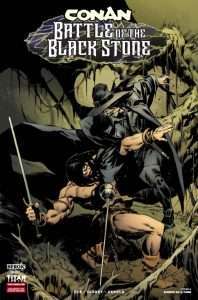 Back in The Wanderer’s Club in 1936 Chicago, Allison’s warning (and the comic’s exposition) is cut short by the emergence of the giant four-armed beast encountered by Solomon Kane in The Savage Sword of Conan #4. El Borak and the occult investigators Professor John Kirowan and John Conrad do their best to keep the creature at bay, but it’s immediately clear they are fighting a losing battle until they receive a last-minute assist from an unexpected ally from another era.
Back in The Wanderer’s Club in 1936 Chicago, Allison’s warning (and the comic’s exposition) is cut short by the emergence of the giant four-armed beast encountered by Solomon Kane in The Savage Sword of Conan #4. El Borak and the occult investigators Professor John Kirowan and John Conrad do their best to keep the creature at bay, but it’s immediately clear they are fighting a losing battle until they receive a last-minute assist from an unexpected ally from another era.
The second issue of the Conan the Barbarian: Battle of the Black Stone miniseries provides deeper insight into the supernatural struggle in which the protagonists have found themselves enmeshed, and it also brings the heroes together for the first time.
Jonas Scharf’s artwork continues to impress. His renditions of the spindly monster first shown by Patch Zircher in The Savage Sword of Conan #4 and of Conan’s Pictish companion Brissa (originally depicted by Roberto De La Torre) are both excellent, proving he can adeptly handle both beauty and the beast. His action scenes also continue to be dynamically portrayed.
Zub’s narration is appropriately portentous as we learn about the stakes the heroes are up against. The Conan vs. Solomon Kane skirmish advertised on the issue’s cover felt a little perfunctory, however, like it was inserted to fulfill comic book readers’ team-up expectations (i.e., first the heroes rough each other up a little, then they join forces) rather than anything demanded by the narrative. I was also disappointed to see that Dark Agnes was given very little to do this issue as well. Perhaps it would have been best had she been omitted from the Battle of the Black Stone
miniseries entirely; the miniseries feel crowded enough as it is.
With Conan the Barbarian: Battle of the Black Stone #2 the board has been set up and the pieces are in place. Only two issues remain in the miniseries, so it appears we can expect a rollercoaster ride in the installments to come.
Read Conan the Barbarian: Battle of the Black Stone #2 by Jim Zub (W) and Jonas Scharf (A)
The post REVIEW: Conan the Barbarian: Battle of the Black Stone #2 appeared first on Grimdark Magazine.
November 14, 2024
REVIEW: Blood of Hercules by Jasmine Mas
In 2050, the world collapsed. Monstrous beings known as Titans appeared and destroyed the Earth. Immortal and impossibly indestructible, they laid waste to cities and civilization. Their destruction had brought forth the apocalypse. History repeats with Spartans rescuing humankind. A new age dawns and Spartans arise as ruthless gods. An original twist of alternate history and reimagined Greek mythology collide in Blood of Hercules by Jasmine Mas.
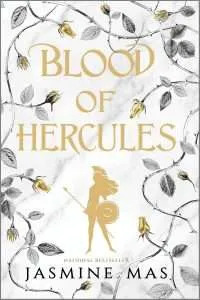 Even by post-apocalyptic standards, Alexis Hert is dirt poor. She has nothing to her name, save the cardboard shelter she and her brother live in. Besides school, she spends her days stealing food vouchers and trying not to smell homeless. Both are equally futile endeavors. Her one hope is to score high enough on the Spartan merit test to secure a better life for her small family. As per usual, fate stomps on her humble dreams. And then on her. After a lifetime of pain, Alexis finds hell.
Even by post-apocalyptic standards, Alexis Hert is dirt poor. She has nothing to her name, save the cardboard shelter she and her brother live in. Besides school, she spends her days stealing food vouchers and trying not to smell homeless. Both are equally futile endeavors. Her one hope is to score high enough on the Spartan merit test to secure a better life for her small family. As per usual, fate stomps on her humble dreams. And then on her. After a lifetime of pain, Alexis finds hell.
Alexis’s life is turned upside down when she is discovered as an abandoned Spartan mutt. She is forced into the Spartan initiation test called the Crucible. Participants will either survive and become a god or die. Alexis has no known powers and no training. Her body is broken from abuse and starvation. She fears people, let alone gods. To top it all, Alexis’s assigned mentors may just kill her themselves. Alexis is doomed.
The opposite of the Mary Sue trope is a well-balanced character. Jasmine Mas achieves that with Alexis Hert in Blood of Hercules. Alexis’s viewpoint is incredibly fun to read. She is 100% grim snark in the best of ways. She has the right dose of dark humor to rebel against her stark reality. Jasmine Mas made Alexis feel like a real person. Mas isn’t afraid to show some of Alexis’s naïve side or her vulnerability.
Jasmine Mas stacks a devilishly entertaining and rather deranged cast of characters in Blood of Hercules. Nyx is Alexis’s best friend. As a snake, she is one of the best animal companions one can read in a book. She is sadistically hilarious and equally endearing. Their banter is a top highlight in Blood of Hercules.
While Alexis Hert is the main character, Jasmine Mas offers glimpses of other characters’ perspectives. Kharon and Augustus are guest professors in this year’s Crucible. Their reputation is death. Their chapters tease some dark plan directly involving Alexis. A scheme undoubtedly heinous. Alexis’s mentor Patro also has his own chapters. More time could have been spent between Alexis and her two mentors, Patro and Achilles. Hopefully more to come in book two. The romance in Blood of Hercules is more of a slow burn until everything is on fire and delightfully crashes down.
Jasmine Mas proves romantasy worldbuilding can rival standard fantasy works. Her worldbuilding is thoroughly detailed and sparks curiosity. The book starts with an introduction to Spartan history. While not long, it may feel like a dense start to some readers. While Blood of Hercules is set in the future of an alternate historical timeline, the laws and some of Spartan culture are archaic. Women are not viewed as equals. Meanwhile, sexuality in this world is open and diverse.
Amidst all the bloodshed, Blood of Hercules by Jasmine Mas is an unapologetic dark romantasy. It is sure to delight readers looking for characters far beyond the morally gray fence post. As the first book in the Villains of Lore series, readers can hope life becomes progressively worse for Alexis Hert.
Read Blood of Hercules by Jasmine MasThe post REVIEW: Blood of Hercules by Jasmine Mas appeared first on Grimdark Magazine.
REVIEW: Gladiator 2
Last Updated on November 14, 2024
Gladiator 2 has been a long time coming. Ridley Scott’s masterpiece arrived at the turn of the millennium and made a megastar of Russell Crowe in the title role. Decades later, we are back in Ancient Rome in the glorious Colosseum in a sequel that may have come as a surprise to many considering the first film’s ending. So Gladiator 2 is here with Paul Mescal in the main role with a lot to live up to – do the film gods stand with Gladiator 2 or should it have been killed with a merciful stroke of the sword?
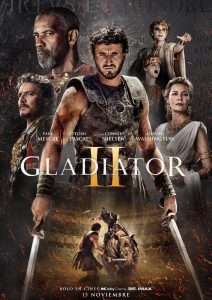 Gladiator 2 is a great film. Paul Mescal holds his own as Lucius, Maximus’s son (bit of a reach following the first one but I went with it), who was sent away from Rome following the events of the first film and now lives in Numidia where General Acacius’s forces arrive to conquer and end up killing Lucius’s wife. Driven by vengeance, he cuts his way through his opponents and rises to the position of gladiator during the Colosseum games thanks to the help of the sneaky Macrinus (played by a film-stealing Denzel Washington who will be making some more room for another Oscar following this perfect performance). Rome is in turmoil and led by brother emperors, both nasty and chaotic and as far away from the dream that Lucius’s grandad Marcus Aurelius had for the great city. Connie Nielsen returns as Lucille, doing pretty much what she did in the first film and looking to convince Pedro Pascal’s (The Last of Us, Game of Thrones) weary General Acacius to overthrow the emperors with his loyal army.
Gladiator 2 is a great film. Paul Mescal holds his own as Lucius, Maximus’s son (bit of a reach following the first one but I went with it), who was sent away from Rome following the events of the first film and now lives in Numidia where General Acacius’s forces arrive to conquer and end up killing Lucius’s wife. Driven by vengeance, he cuts his way through his opponents and rises to the position of gladiator during the Colosseum games thanks to the help of the sneaky Macrinus (played by a film-stealing Denzel Washington who will be making some more room for another Oscar following this perfect performance). Rome is in turmoil and led by brother emperors, both nasty and chaotic and as far away from the dream that Lucius’s grandad Marcus Aurelius had for the great city. Connie Nielsen returns as Lucille, doing pretty much what she did in the first film and looking to convince Pedro Pascal’s (The Last of Us, Game of Thrones) weary General Acacius to overthrow the emperors with his loyal army.
Gladiator 2 lives in the shadow of the original. There haven’t been many performances as good as Crowe’s since and nothing has touched the quality when using Ancient Rome as a setting (Those About to Die being one example). It at times suffers from legacy sequel syndrome where it relies too much on the earlier film for the plot beats and ends up feeling like a parody of itself. With a weaker director and cast, this would stick out like a xenomorph in the colosseum but Gladiator 2 is filled with phenomenal performances from its incredible cast and amazing set-pieces. There isn’t a weak performance in the film and Mescal in particular deserves praise for donning the gladiator gear in the knowledge that he would be compared to such a great. He works alongside some greats of the screen and more than holds his own throughout as a man focused only on revenge to begin with but then growing to see that he could be part of something more. Some of the writing forces the comparisons with Crowe which doesn’t do him any favours but he comes out of this film with his star shining brighter than ever. Joseph Quinn (Stranger Things) and Fred Hechinger play the young emperors well with manic glints in their eyes and again, they make the roles their own whilst trying to distance themselves from the brilliance of Joaquin Phoenix in Gladiator.
As expected from a Ridley Scott movie, the set-pieces are incredible. The opening battle is brilliant and brutal as General Acacius leads his troops in an attack against Numidia and the scenes in the colosseum deserve to be seen on the big screen. I never thought I’d see a mock sea battle with sharks in the colosseum but I’m glad I have. The violence in Gladiator 2 will delight grimdark fans as Scott’s direction lingers on the brutality of Rome at its most chaotic and the camera never shies or pulls away from the brutality of life being cut away in an instant. Gladiator is about life and death and actions that live on forever and echo through eternity and the action focuses on this throughout and makes the story better for it.
Gladiator 2 may have a Russell Crowe sized hole in it, but it is another great Ridley Scott film in Ancient Rome filled with great performances from a cast on the top of their game. At times it leans on the original a bit much but when the original is that good, I can’t really blame them. Gladiator 2 is a brutal action film that builds on the legacy of a masterpiece and deserves to be seen on the big screen. You will certainly be entertained!
The post REVIEW: Gladiator 2 appeared first on Grimdark Magazine.
November 13, 2024
REVIEW: House of Bone and Rain by Gabino Iglesias
Family is everything, even if it means following your family into a bloodbath. House of Bone and Rain by Gabino Iglesias explores a blood-soaked, noir-horror world where loyalties between blood brothers are tested and asks how far would you really, truly go for a friend in need? What would you actually do for them? How much blood would you spill for them?
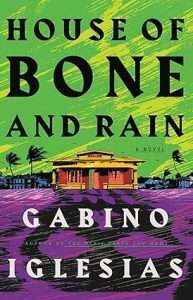 What I loved about this novel was its pacing. Right from page one, House of Bone and Rain brings you into a world of death and revenge. Set in Puerto Rico before the arrival of a deadly hurricane, the story follows Gabe, a young man with a group of friends he’d do anything for. He and his friends Xavier, Tavo, Paul, and Bimbo follow a simple code: “if you fuck with one of us, you fuck with all of us”. When Bimbo’s mother, María, is murdered at the club she works at, Bimbo cashes in on that loyalty and asks them for help getting revenge. It’s a classic morality tale that forces the reader to look at Gabe to see where the bar stops: their path to truth leads to murder, which leads to people who might know the answers they seek, which then leads to more murder. It’s a vicious, violent cycle, and Gabe falls into this cycle because that’s what you do for family. I really liked the struggle that Gabe is constantly trying to work through: does he continue helping Bimbo get revenge, even though it may cost him his life and the lives of his friends and family?
What I loved about this novel was its pacing. Right from page one, House of Bone and Rain brings you into a world of death and revenge. Set in Puerto Rico before the arrival of a deadly hurricane, the story follows Gabe, a young man with a group of friends he’d do anything for. He and his friends Xavier, Tavo, Paul, and Bimbo follow a simple code: “if you fuck with one of us, you fuck with all of us”. When Bimbo’s mother, María, is murdered at the club she works at, Bimbo cashes in on that loyalty and asks them for help getting revenge. It’s a classic morality tale that forces the reader to look at Gabe to see where the bar stops: their path to truth leads to murder, which leads to people who might know the answers they seek, which then leads to more murder. It’s a vicious, violent cycle, and Gabe falls into this cycle because that’s what you do for family. I really liked the struggle that Gabe is constantly trying to work through: does he continue helping Bimbo get revenge, even though it may cost him his life and the lives of his friends and family?
I’ve always been a fan of Gabino Iglesias’s writing; he does bloody noir in such a compelling way that you’re obliged to keep turning pages, long into the night. That trend continues with House of Bone and Rain. The second a chapter ends, the second I wanted to turn to the next one. Iglesias strategically allows the pacing to slow down for just a moment, only to whisk you away in the next bloody conflict. It’s brilliant stuff.
As House of Bone and Rain continues, Gabe and Bimbo’s quest gets more complicated and much darker than it starts. Watching Gabe and Bimbo’s friendship strain under the circumstances makes for an interesting character study and fantastic fiction. Time and time again, they are brought together under the auspices of “family”, but how far can that excuse take them? How many people have to die for them to call it quits, if they even can?
My time spent with House of Bone and Rain didn’t feel like spent time at all; the second I opened the book, I was finished with it. Iglesias weaves a world that’s full of murder and questioning moralities, brotherly ties and familial obligations, tradition and loyalty. It asks if what we do for our closest friends is ever enough, and if, sometimes, they may just ask too much of us.
Read House of Bone and Rain by Gabino IglesiasThe post REVIEW: House of Bone and Rain by Gabino Iglesias appeared first on Grimdark Magazine.
November 12, 2024
REVIEW: Grave Empire by Richard Swan
Author Richard Swan takes us back into the Empire of the Wolf with Grave Empire, the dark flintlock fantasy horror with sweeping epicness, an intense and building sense of dread, and characters grimdark fans are going to really enjoy. Fans of The Justice of Kings, The Tyranny of Faith, and The Trials of Empire are in for an absolute treat, and new readers can pick this up without having read the previous trilogy.
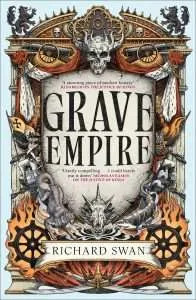 Renata is secretary to Sova’s diplomat to the Stygion underwater empire, an unimportant bureaucrat to an unimportant nation. Having never actually seen or spoken to the mer-people, she’s about to be thrown into the deep end of diplomacy. Peter took a commission in the Sovan army hoping for a role away from the front lines, but ends up marching to the ends of the empire. As the very lands around him become more alien and dangerous, he starts to quickly question allowing his father to purchase a commission for him. Von Oldenburg is a noble playing outside the laws of Sova to try and return magic to the empire, where it is now outlawed 200 years after the events of The Trials of Empire wrapped up Swan’s first fantasy trilogy in this world. When he discovers signs of The Great Silence, he sees opportunity for victory and profit.
Renata is secretary to Sova’s diplomat to the Stygion underwater empire, an unimportant bureaucrat to an unimportant nation. Having never actually seen or spoken to the mer-people, she’s about to be thrown into the deep end of diplomacy. Peter took a commission in the Sovan army hoping for a role away from the front lines, but ends up marching to the ends of the empire. As the very lands around him become more alien and dangerous, he starts to quickly question allowing his father to purchase a commission for him. Von Oldenburg is a noble playing outside the laws of Sova to try and return magic to the empire, where it is now outlawed 200 years after the events of The Trials of Empire wrapped up Swan’s first fantasy trilogy in this world. When he discovers signs of The Great Silence, he sees opportunity for victory and profit.
In Grave Empire, Swan takes us on a bloody adventure across the vast empire of Sova in all of its crumbling glory. Sova’s forces are losing a war to the Casimir on one far border, and a new evil rears its head on another, threatening to destroy not only Sova but all the peoples in this mortal plane. The dark magic system from the first trilogy remains–though its use in anything other than the science-ish based nature of construction is now illegal–and we are pulled into a world of musket and cannon, man-o’-wars and empires under the waves, and terrifying beings come back from the burned and hidden pages of history to wreak havoc on the people of Sova.
The sense of growing dread Swan builds through Grave Empire is brilliantly crafted. Swan uses the sheer scale of the frontiers of Sova–with immense dense forests where humanity has yet to tread creating a feeling of emptiness and the unknown–in the way only the best exploration horror cinema does. The expansive travels of the protagonists help the reader experience not only a series of cities and geographies which change as you reach the borders of civilisation, but the terror of discovering they are, in fact, not alone. This feeling is one of the key drivers of making this book incredibly difficult to put down.
Fans of the epic dark fantasy procedural trilogy The Empire of the Wolf and the space opera The Art of War (Reclamation, The Ascendancy War, The Empire of the Fallen), can expect new themes rooted in the old in Grave Empire. There is plenty of crumbling empire (cynically commented on with each chapter’s usually darkly funny starting epithet), very human characters dealing with their fears and foibles while desperately trying to both survive and succeed, a massive sense of epicness in world of scale and consequences, and a brilliant feeling of agency across all of the competing factions that only the best fantasy brings to the table.
Absolutely crammed with imagination, horror, epic scale, and characters I simply could not put down. I’m calling it now: Grave Empire is going to be one of the best dark fantasies 2025 has to offer.
Read Grave Empire by Richard SwanThe post REVIEW: Grave Empire by Richard Swan appeared first on Grimdark Magazine.
November 11, 2024
REVIEW: The Songbird and the Heart of Stone by Carissa Broadbent
Okay friends, when I tell you that Carissa Broadbent is on FIRE in The Songbird and the Heart of Stone, I mean she set my heart and soul aflame and then remorselessly left them burnt to a withered crisp by the end. Get ready to sink your teeth into a brand-new exquisitely soul-stirring and divinely epic slow-burn fantasy romance full of death, desire, treachery and heart-wrenching emotions that just bleed off the page.
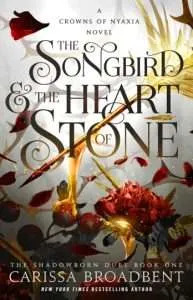 First things first, let me share an important message: The Songbird and the Heart of Stone might be the first book in the new Shadowborn Duet, but you do not (I repeat, DO NOT) start your journey into the Crowns of Nyaxia world here. Sure, Broadbent’s writing is absolutely strong and captivating enough that you could be a rebel and skip the preceding Nightborn Duet, starting with Serpent and the Wings of Night, but why would you do that and miss out on a lot of important context as well as deprive yourself of another phenomenal blood-soaked love story?
First things first, let me share an important message: The Songbird and the Heart of Stone might be the first book in the new Shadowborn Duet, but you do not (I repeat, DO NOT) start your journey into the Crowns of Nyaxia world here. Sure, Broadbent’s writing is absolutely strong and captivating enough that you could be a rebel and skip the preceding Nightborn Duet, starting with Serpent and the Wings of Night, but why would you do that and miss out on a lot of important context as well as deprive yourself of another phenomenal blood-soaked love story?
Okay, with that out of the way, it’s time to let the gush fest begin! From the moment I met Mische in The Serpent and the Wings of Night, she immediately became one of my favourite characters of the entire series. Although she could come across a bit vapid and shallow at times, I had a feeling there was a lot of pain and trauma hiding behind the mask of giddy smiles and relentless optimism, which I could not wait to dig into in The Songbird and the Heart of Stone.
Now, when Mische set off to discover the world on her own at the end of the Nightborn Duet, I was not expecting to meet her again as she is thrust into the underworld together with the bastard heir of The House of Shadows (and his spirit wolf, Luce, the true MVP of the show) on a deadly quest to resurrect the God of Death. But holy smokes, did this end up to be exactly the adventure that my dark hole of a soul wanted and needed; to my huge surprise, there wasn’t even a single moment where I missed Raihn and Oraya, and I am now just as (if not more) invested in Asar and Mishe’s story.
First of all, these two are quite literally the perfect embodiment of the grumpy/sunshine trope, and I absolutely loved how their effortlessly amusing dynamic added so much heart and humour to this otherwise dark and emotionally draining story. Broadbent really is the queen of the slow-burn for me, and the way that Mische and Asar semi-reluctantly started to bond throughout this harrowing journey and eventually help each each other understand what honest love and devotion is supposed to feel like just tugged on my heartstrings in all the best ways. The reason why their romance feels so believable and intimately vulnerable to me, is because the physical/sexual attraction comes second to their emotional attraction and bonding; this is exactly what ultimately makes The Songbird and the Heart of Stone stand out in the crowded romantasy space for me.
Moreover, while there is plenty of action (of both the fighting and the steamy kind, hello delicious blood sucking scene!!!) to satisfy the plot-driven readers, my character-driven heart was truly sucking up all the inner turmoil, unpacking of trauma and the unravelling of all the complex interpersonal relationships. Especially Mische’s complicated dynamic with her god Atroxus had me in an absolute chokehold, and I really appreciated the authentic and deeply vulnerable exploration of themes of (childhood) trauma, faith, devotion, vengeance, forgiveness (of others and oneself), and the dangerously thin line between love and hate.
The emotional character journey in The Songbird and the Heart of Stone is honestly more multi-layered and tear-inducing than an onion, and I absolutely loved how Broadbent meticulously heightened the stakes, increased the tension, and peeled back a new layer of complexity and emotional depth every time these characters progressed to a deeper level of the underworld. In both flashbacks and the present, we see Mische and Asar as they are quite literally being hunted and haunted by the ghosts of their pasts, which not only unveiled their intriguingly dark backstories in the most enticing way possible, but also established such a deep emotional connection for me that was honestly not safe for my own sanity.
Now, while this book started out with immediate ‘new favourite’ potential for me because its vibe and aesthetic reminded me so heavily of other deliciously dark fantasy favourites like Empire of the Vampire by Jay Kristoff or Asunder by Kerstin Hall, I do personally think the second half is where the true gold can be found. Especially parts 2 and 3 felt slightly hectic and oddly paced to me, with some important character/relationship progression happening off screen and side characters not getting the development I was hoping for.
Those little nitpicks didn’t stop me from obsessively devouring this book like nobody’s business, yet it was in part 4 (of 7) that I think Broadbent just fully hit her stride; from that point onwards, we just go through the wildest emotional rollercoaster, leading straight up to a brutally bittersweet ending that I could/should have seen coming yet which still ripped my heart out of my chest and left me staring blankly at a wall for a few minutes. The audacity to end with such a diabolical cliffhanger of an ending, and then make me wait for book 2… unacceptable, but I love the heartache.
In my humble opinion, The Songbird and the Heart of Stone is not only Broadbent’s best work to date, but it also just raised the bar for every other dark romantasy to come. With its deeply flawed yet lovable morally grey characters, cutthroat vampire politics, haunting imagery, blood-soaked history and rich lore, fickle meddling gods, dangerous necromancy, and exquisite levels of emotional destruction, even the most cold-hearted grimdark enthusiasts will find much to love in The Crowns of Nyaxia series; also, it’s got a loyal skeletal spirit wolf companion, what more could you ask for?!
Thank you to Tor Bramble for providing me with an eARC in exchange for an honest review. All opinions are my own. The Songbird and the Heart of Stone is scheduled for release on November 19, 2024.
Read The Songbird and the Heart of Stone by Carissa BroadbentThe post REVIEW: The Songbird and the Heart of Stone by Carissa Broadbent appeared first on Grimdark Magazine.
November 10, 2024
REVIEW: Conan the Barbarian #16 by Jim Zub (W) and Doug Braithwaite (A)
Last issue, Conan experienced a close encounter with the divine. Sole survivor of a battle between rival tribes of Northmen, Conan found himself visited by Atali, daughter of the mythic frost giant Ymir. Conan the Barbarian #16 opens with Conan back at the Aesir camp, reflecting on his brush with the otherworldly. Left with a scrap of Atali’s diaphanous garment as the only physical proof of his experience, Conan recalls his own religious upbringing in Cimmeria, where the inhabitants worship the grim and notoriously distant deity Crom.
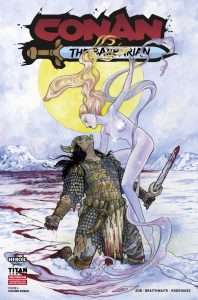 Conan the Barbarian #16 serves as a denouement to the Frozen Faith storyline, following the expanded retelling of Robert E. Howard’s short story “The Frost-Giant’s Daughter.” Doug Braithwaite’s artwork matches the standard we’ve seen from him to date, and Jim Zub’s script features its usual punchiness.
Conan the Barbarian #16 serves as a denouement to the Frozen Faith storyline, following the expanded retelling of Robert E. Howard’s short story “The Frost-Giant’s Daughter.” Doug Braithwaite’s artwork matches the standard we’ve seen from him to date, and Jim Zub’s script features its usual punchiness.
However, from both an art and storytelling perspective, this four-issue arc felt like a misstep. His earthly women are fine, but as an artist Braithwaite was not up to the task of effectively rendering Atali’s ethereal beauty. For Zub’s part, I don’t feel like this was particularly an episode that needed telling. In addition to the original prose short story, readers have a number of comic adaptations of “The Frost-Giant’s Daughter” to choose from. The Braithwaite/Zub interview included in the issue’s backmatter provides some interesting insight into the genesis of this version: Braithwaite was a fan of the 1970s Marvel Comics adaptation by Roy Thomas and Barry Windsor-Smith and wanted to try his own take on the tale, and Zub felt that positioning Atali herself as narrator would be novel enough to justify the retelling. While Zub succeeds in making Atali more of a three-dimensional character and less a cipher than in the original Howard story, he doesn’t go far enough. Atali is depicted appraising humanity through her close observation of Conan and his indomitable fighting spirit, but her ultimate objective remains as murky as ever. What is her endgame here?
Apart from “The Frost-Giant’s Daughter” being well-trodden ground, the emphasis on Conan’s childhood and religious beliefs does not sit well with this reader. Unlike some other varieties of fantasy fiction, Sword & Sorcery heroes do not need elaborate backstories and are rarely given them. The genre is almost always concerned with the here and now: what fresh hell has the protagonist found himself embroiled in, and how is he or she going to extricate themselves? Flashbacks of Conan as a sullen child dealing with village bullies and butting heads with his apparently devout Crom-worshipping father are not something I seek in Conan the Barbarian. Conan’s creator never gave readers more than the barest sketches of the barbarian’s origin, and they were sufficient to make him the enduring character he is today, more than 90 years later. In comics, films, and pastiche novels, other stewards of the character always seem irresistibly tempted to backfill, but readers don’t need it. They really don’t. Tell me what Conan is doing NOW, not what he did when he was eight years old.
The preoccupation with Conan’s religious faith is likewise unnecessary and does little to enhance the character. The passage is touched upon in the accompanying essay by Jeffrey Shanks, but as far as this reader is concerned, the last word about Conan and religion is captured in Howard’s “Queen of the Black Coast” (1934):
“I have known many gods. He who denies them is as blind as he who trusts them too deeply. … I know not, nor do I care. … Let teachers and priests and philosophers brood over questions of reality and illusion. I know this: if life is illusion, then I am no less an illusion, and being thus, the illusion is real to me. I live, I burn with life, I love, I slay, and am content.”
In short, Conan has been around and encountered some strange things. He knows the supernatural exists, and has concluded that gods are likely to be present as well. Regardless, he has elected to remain unconcerned by questions of religion and live his own life. Granted, the Conan of “Queen of the Black Coast” is older and more seasoned than at the time of the Frozen Faith storyline, but the spiritual journey of Crom-skeptic to Crom-believer told here feels inappropriately pensive for a character that is overwhelmingly concerned with the tangible, the here and now. Howard had other characters better suited to stories about religious belief. King Kull was a philosopher, for example, and Solomon Kane’s fanatical Puritanism motivated every action he took. Conan, however, shrugs at your religion. Try to crowbar a crisis of faith into a Conan story and you risk getting into “Are You There, Crom? It’s Me, Conan” territory.
Conan the Barbarian #16 marks the end of a flawed experiment. While it ultimately didn’t work for me, it was interesting to see the creative team’s take on an expanded adaptation of a classic story. Thus far, over the course of Titan Comics’ Conan the Barbarian we’ve had a continuity-heavy year-long plot, time travel, numerous flashbacks, and multiple crossovers with other literary Howard characters. Now that the breadth of Howard’s universe has been demonstrated, here’s hoping that the series returns to its core appeal: fast-paced, original episodic adventures showing the barbarian operating at the height of his powers.
Read Conan the Barbarian #16The post REVIEW: Conan the Barbarian #16 by Jim Zub (W) and Doug Braithwaite (A) appeared first on Grimdark Magazine.
November 9, 2024
REVIEW: Before the End by John Palladino
In Before the End, John Palladino gives a grimly entertaining and morbidly captivating glimpse into the darkest corners and most twisted minds to be found in the world of Cedain. Full of dark humour, tragic irony, morally grey anti-heroes, and prose sharper than any knife, this short story collection is a true feast of deliciously sickening grimdark delights. 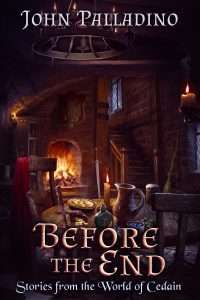 “There wasn’t a person Royal cared more about than himself, or alcohol. He did have morals though. But to stand up for those morals? That was a different matter. If he stood up for them, he’d jeopardize himself. Can’t do that.”
“There wasn’t a person Royal cared more about than himself, or alcohol. He did have morals though. But to stand up for those morals? That was a different matter. If he stood up for them, he’d jeopardize himself. Can’t do that.”
I have said it before and I will say it again, no one comes as close to Abercrombie’s tone and character voice as John Palladino does. Within just a few pages, I was immediately reminded of why I fell in love with his writing in the first place, and I found myself stunned by how many little details of both the world and the characters felt familiar to me considering how long it had been since I had last visited Cedain. See, Palladino’s characters have so many memorable quirks and recognizable idiosyncrasies, which not only makes them leap off the page with personality (for better or worse), but which is also exactly what makes each story in this collection feel so refreshing and uniquely exciting.
Although the eleven stories in Before the End aren’t told in a chronological order and don’t feature a connective red thread like in Abercrombie’s Sharp Ends, Palladino manages to infuse this entire collection with an addictive ‘just one more chapter’ quality that just keeps you turning the pages to discover the next dark and tragic mess to cry or laugh over. Whether it’s the shocking backstory of the most beloved (or let’s be real, most hated) characters from The Trials of Ashmount and Buzzard’s Bowl, or an introduction to a completely new character who provides a refreshing perspective into this dark world and devastating magic system, each of these stories is just a true train wreck that you simply can’t look away from (and I say that in the most loving way possible).
“Velturo wanted to retch. No respect. But life was politics, and there wasn’t respect within politics. He ground his teeth together. “Fine, ah-hah.” That damned laugh. It’d never make him sound fearsome.”
Before the End kicks off with a deliciously dark and depressing story that went straight down the gullet for me (iykyk), and from there on out I just could not stop reading. Now, while my dark hole of a soul was truly eating up the relentlessly dark, depressing and hopeless tone running through this entire collection, I can see how some readers might feel like these stories are pointless or dissatisfying because they share a certain level of predictability regarding the inevitably tragic fate of the characters.
But hey, grimdark is not the subgenre to come to if you want sunshine and rainbows, and I ultimately think Palladino more than nailed his vision for this collection. While some stories worked better for me than others, I think they were all inexplicably captivating in their own uniquely messed up way. If I had to pick favourites, I’d say my personal highlights include A Royal Mission, Child of Children, Hiding in Plain Sight (featuring a very well-named tavern, btw), Bloody Gums, No Respect, and, saving the best one for last: A Tale of Two Twins. These stories had just a certain ‘je ne sais quoi’ that made them hit harder than I was anticipating, making me tear up from both laughter, frustration and pain.
“She’d do whatever he wanted if it meant a better life. Murder would be just fine. Well, ain’t this a way to end an urchin’s story?, she thought. Of course, it didn’t turn out the way she hoped. But did it ever?”
In Before the End, John Palladino proves that a skilled storyteller doesn’t require a lot of words to deliver one hell of a memorable reading experience. While this collection was originally intended as a bridge between books 1 and 2 in the Tragedy of Cedain series, the stories are very self-contained and feature zero spoilers, so I personally think this could serve perfectly as a tantalising first taste of Palladino’s exceptional writing skills. Ultimately, the point is not where you start with Palladino’s writing, but when you start; the Tragedy of Cedain series is honestly a dream (or nightmare?) come true for any true grimdark fantasy lover, so do yourself a favour and don’t miss out.
Thank you to the author for providing me with an eARC in exchange for an honest review. All opinions are my own. Before the End is scheduled for release on 11 November, 2024.
The post REVIEW: Before the End by John Palladino appeared first on Grimdark Magazine.
November 8, 2024
REVIEW: The Queen by Nick Cutter
Sometimes, obsession is sparked by one defining moment. An all-consuming tragedy can mutilate a person’s mind, flaying it layer by layer until only fixation remains. Obsession can be a nest. Rotting twigs of unreciprocated love and fear as its foundation. Nick Cutter burrows into the human psyche and concocts unfathomable horror in his new book, The Queen.
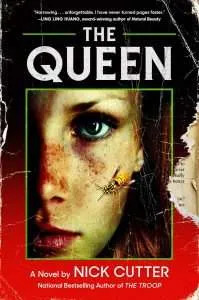 The reader is immediately swallowed by Nick Cutter’s nightmare in The Queen. Its first scene is disconcerting and unrestrained. It doesn’t tease the awaiting horror. It is a bloodbath exhibition. The bold opening in The Queen leaves no doubt, this is Nick Cutter writing in his element.
The reader is immediately swallowed by Nick Cutter’s nightmare in The Queen. Its first scene is disconcerting and unrestrained. It doesn’t tease the awaiting horror. It is a bloodbath exhibition. The bold opening in The Queen leaves no doubt, this is Nick Cutter writing in his element.
Nick Cutter’s writing is best known for pushing the limits on body horror and human wretchedness. The Queen is Nick Cutter’s MO perfected. Amongst chaos, Cutter cultivates a sobering tale about the loss of youth.
Four students are missing from Northfield High. Margaret Carpenter’s best friend Charity is one of them. The Queen follows Margaret as she unravels the mystery surrounding her best friend. Prior to Charity’s disappearance, they had been growing apart. The intensity of Margaret’s guilt gives a gnawing dark impression. It forces readers to wonder. What did Margaret do to feel like she is a bad friend? The reader is also privy to some of Charity’s perspective and the insight of other students. Northfield High feels real. A school bustling with gossip and traditions. Its horror stories spill from the student body.
Nick Cutter captures the painful experience of nearing adulthood; the internal war with identity, and fear of outgrowing friendships and childhood expectations. The ease in which Nick Cutter progresses the corruption of thoroughly relatable characters is unsettling. Cutter blasts this damning message each time; monsters are born within us. They are us.
A distorted concept of nature versus nurture is mused throughout Nick Cutter’s works. In his earlier book The Troop, there is something…other regarding the character Shelley. Characters may sense something is off or not quite normal but are unable to pinpoint why. A similar vibe is felt with Rudyard Crate, the second main character in The Queen. His tragic childhood stirs sympathy, but such feelings are muted due to the man he becomes. These characters breach the lines of morality. It strokes a certain curiosity and desire to understand real monsters, if such a thing exists.
It may be impossible to count all the easter eggs and references strown throughout this novel. The Queen by Nick Cutter is a tribute honoring the pioneers of horror. A perfect collage of classic horror pasted beside snapshots of modern pop culture.
Read The Queen by Nick CutterThe post REVIEW: The Queen by Nick Cutter appeared first on Grimdark Magazine.



